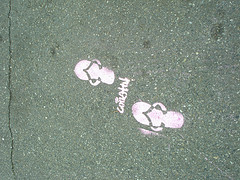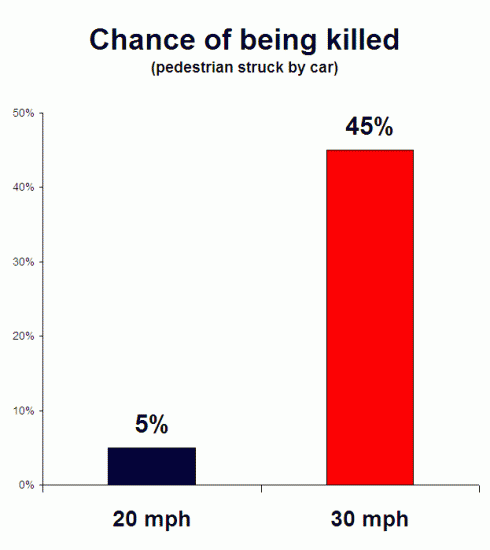It’s been nearly two years since we started getting exercised about this: It shouldn’t take expensive engineering studies for city hall to lower speed limits. Then we made the argument again. And again. Last week, Washington State relented, becoming one of the last in the Northwest to remove what had been a serious roadblock for cities and towns that sought to calm traffic, make neighborhoods safer, and reduce speed limits on residential and business non-arterial streets.
It’s a big win for anyone who finds themselves (as I have) standing in the middle of a narrow street, daring the driver (who is too important or in too much of a hurry to wait at the light one block away) to run you over as you attempt to fish a kid’s lunchbox from the back seat of your own parked car.
The Neighborhood Safe Streets Bill (HB 1045) passed the state Senate in the last minute before a cutoff deadline that would have killed it for the third year in a row. It required a special order of business led by Sen. Andy Billig (D-Spokane) to bring the vote to the floor. The bill simply allows cities to reduce speed limits to 20 mph on side streets without having to do expensive traffic engineering studies. This frees up money and capacity to make real safety improvements that reduce speeding, cut-through traffic, and possibly the chances that a Seattle mom, a 10-day old baby and grandparents would be mowed down in afternoon traffic.
That’s because lower speed limits save lives. In dramatic fashion. As the graphic below shows, the chances of a pedestrian being killed in a collision with a car increases ninefold as speed limits climb from 20 mph to 30 mph.
So while last week’s vote was great news, here’s something to ponder: Why did it take three years to pass a common sense bill that will save lives and received virtually no opposition in testimony or otherwise? After all, a version of the Safe Streets bill passed the Washington House of Representatives unanimously in 2011 and 2012. It had bipartisan support and the blessings of cities, towns, AAA, the AARP, children’s organizations, public health experts, and the Bicycle Alliance of Washington.
In this case, voters decided last November to oust longstanding Senate Transportation Committee Chair Mary Margaret Haugen (D-Camano Island), who was never interested in pushing the Safe Streets bill out of committee. But more broadly, the structure of our political system currently gives minority factions the power to put even common sense solutions with wide support in a stranglehold. So to see more wins like these, it’s time to work on changing the rules of the game.










Rick Mohler
Great to see this pass! But it will ultimately be meaningless without diligent enforcement.
benschon
It be more accurate to say that “lower speeds save lives.” The bar graph is not related to the legal restriction, it’s explaining the impact of the actual speed, regardless of the limit.
norse
Well, the graph actually only demonstrates that the number 45 is 9 times as large as the number 5.
It would be interesting to look at the source data – was this based on expert estimates or some form of statistics? If so, I’d be interested in the confounders – are we talking about being struck at exactly 20mph vs exactly 30mph or the ranges 0-20 and 30-infinite? If the number is derived from deaths based on general accident statistics, it would be interesting to eliminate the confounder of the speed distribution in the data.
Quoting scientific data without source attribution is pretty useless and prevents much needed debate.
There are a number of studies that present evidence that lowering (or raising) speed limits has little to no impact on traffic fatality rates and that other factors (visibility, driver distraction have more of an impact). Here are two links to provoke discussion: http://www.ibiblio.org/rdu/sl-irrel.html, http://www.carbibles.com/speeding_facts.html.
There is a danger in reducing a complex problem to just one easy-to-measure variable, and the speeding discussion strikes me as an excellent example of this. My prediction is that ten years from now, traffic accident rates and pedestrian death rates in Seattle won’t change substantially unless we take other measures, like introducing better delineated separate space for pedestrians, bikes and cars, with sufficient lighting and visibility especially at street corners.
On the flipside, based on the British studies that demonstrated that driver distraction the most important contributor to traffic accident rates, my hope is that self driving cars will make all the difference in the long run, by eliminating the largest risk factor from the equation.
Jeremy
Self-driving cars? Assuming those actually pan out, what will be done about the surge in unemployment as businesses slash their costs by eliminating bus drivers and taxi drivers and truckers and so on from their payrolls? Because humans are expensive, and robots, a few software developers, and a management chain likely cheap, in comparison.
Also, why even bother with cars? Unless the self-driving cars—assuming their existence, again—drive the occupant 10 miles out of town and then shutdown, instead of taking the occupant to where they wanted to go, say, perhaps, the Cheesecake Factory, the populace will tend towards the sickness and obesity easily observed in car-addicted areas[1]. I know! Maybe a self-driving robot could deliver a self-steering bicycle to the user, who would then pedal off their extra pounds… ahh, future technology! So amazing!
[1] https://www.youtube.com/watch?feature=player_detailpage&v=WHet2jjHtk4 (from Weekend Reading 3/8/13)
Chkymnky
To clarify the reference to the unfortunate family that was mowed down by a driver, wasn’t the driver drunk? Will a speed limit change make a difference? Just how many individuals have actually been struck by drivers who were not drunk or distracted by an electronic device? Those numbers would help make this case. The ones used here do little to support the legislation.
Jason M
If you are a Mother and you are riding your bike in Downtown Seattle traffic with your kid on the back, you are the biggest idiot on the face of the earth. Straight up. You are putting your child’s life in immediate danger and you should be ashamed of yourself for thinking that you can ride your bike in traffic and be safe in this city. Every other day I read a news article about how a bicyclist has been hit in traffic. Why would you do this to your child? If you want to be stupid and ride your bike in traffic, that’s one thing. Riding your bike with your kid strapped to the back is attempted murder. When a car hits you and kills you, it doesn’t matter who’s fault it is. When you’re dead, you’re dead.